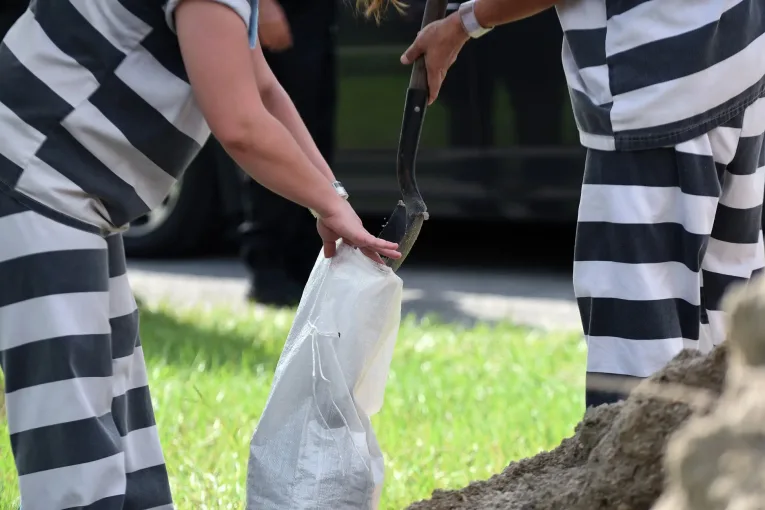
Before hurricanes Helene and Milton, officials failed to evacuate people in jails and prisons—yet most states rely on incarcerated people to work disaster response for little to no pay.
When the need arises for disaster preparation, response, and recovery efforts, incarcerated people are put to work. With cleanup efforts underway in the aftermath of Hurricane Helene, they have cut down trees and cleared hundreds of miles of roads in Virginia. In Florida, they not only removed debris left by Helene but also helped prepare for Hurricane Milton by filling sandbags for other residents.
“We’re utilizing our resources,” said Florida Governor Ron DeSantis after Helene made landfall in the state. “We’ve got low-security inmates that are out there who do normal prison labor. The Department of Corrections is bringing them to help with hurricane cleanup.” He added that this work “would cost [the state] way more money if [it] had to do that through some of these private contractors.”
DeSantis’s egregious comments call attention to an exploitative practice that forces incarcerated people to labor for pennies per hour or, in many cases, nothing at all. This is legal because the Thirteenth Amendment abolished slavery but made one significant exception: people convicted of crimes could be forced to work. It is modern-day slavery, shielded by the Constitution.
And when disaster hits, people held in jails and prisons are often left behind—sometimes without food, water, or medicine—as state and local officials fail to evacuate jails and prisons located in mandatory evacuation zones.
Forced labor and disaster response
At least 30 states explicitly include roles for incarcerated people in their official emergency response plans, according to a report by the National Employment Law Project. Many states’ Emergency Operations Plans (EOPs) outline that “offender labor” and “correctional facility work crews” are to be available for tasks like sandbagging, cleanup, and fighting wildfires.
As DeSantis’s comments show, this forced labor—an immoral, albeit legal, practice—is incredibly financially beneficial to states. In fact, elected officials will sometimes go further than DeSantis and admit that their states could not afford to engage in disaster response without relying on the labor of incarcerated workers. Incarcerated people are neither fairly compensated (if at all) for this grueling work, nor are they extended the standard health and safety protections that other workers receive.
In most cases, incarcerated workers are excluded from Occupational Safety and Health Act (OSHA) protections—workplace safety is deemed a “privilege” that doesn’t apply to them. Corrections departments sometimes refer to incarcerated people who perform disaster preparation, response, or recovery work as “volunteers”—a classification that exempts those doing this work from legal worksite protections. In some states, participation is hardly voluntary, as refusing to work can incur serious consequences, including solitary confinement.
Abandoned during crises
While incarcerated people are exploited for their labor in natural disasters, they are also abandoned when wildfires rage or floodwaters rise. They have frequently been left behind without food and water as hurricanes make landfall, even when facilities are located within mandatory evacuation zones.
This time has been no different. Florida counties forced residents to evacuate ahead of Helene and Milton but neglected to make plans to evacuate people locked in jails and prisons located in mandatory evacuation zones. As Milton barreled toward Florida, as many as 28,000 people were reportedly held in jails and prisons in mandatory evacuation zones.
Although the Florida Department of Corrections claimed to have evacuated about 6,000 incarcerated people, in some cases, they were simply relocated to “hardened” facilities just yards away.
Even those who were evacuated faced dire circumstances. One woman told The Appeal that her son had been moved to a unit that was “absolutely filthy.” One person who was evacuated to another Florida facility ahead of Milton said they were literally “left in the dark”: “We’re shouting for meds and updates, but no one’s listening.”
In North Carolina, which suffered the worst of Helene’s impact, 2,000 people from five prisons were evacuated and moved to other facilities. However, delays in that process meant that people incarcerated at Mountain View Correctional Institution in Spruce Pine were forced to stay as their cells flooded. They remained without lights, running water, or functional toilets for almost a week before they were transferred to another facility.
As the impact of climate change becomes increasingly acute, incarcerated people are particularly vulnerable—just as they were during the COVID-19 pandemic. They are more likely to be exposed to environmental harms than the overall population. And their safety is entirely out of their hands. Corrections staff are also affected; while other employers can close their businesses, corrections professionals are required to work through the storm despite the risk of injury and the need to protect their families. Officials must create evacuation plans and carry out those plans when natural disasters threaten communities for the safety of both incarcerated people and staff.
End forced labor in prisons
Forced prison labor of any form is unjust, as is the exclusion of incarcerated workers from workplace safety laws. Every state should amend its constitution to prohibit the forced labor of incarcerated people and extend basic labor protections to them. At the federal level, the Correctional Facilities and Occupational Safety and Health Act would explicitly grant OSHA protections to incarcerated people. And the Abolition Amendment would finally close the loophole that has permitted the forced labor of incarcerated people to the present day. Only then will slavery become a part of the United States’s past. For now, it is still very much a part of its present.
Originally published by Vera Institute of Justice – Nazish Dholakia is a staff writer.